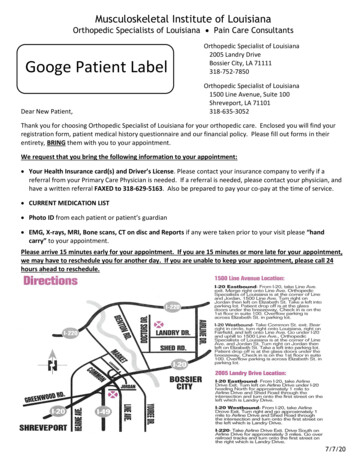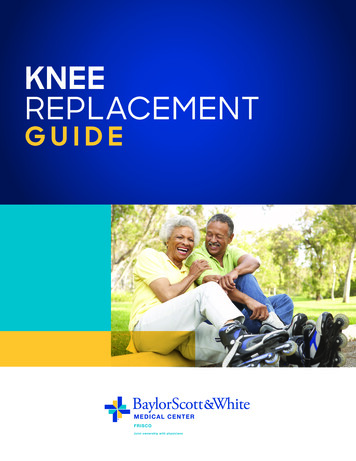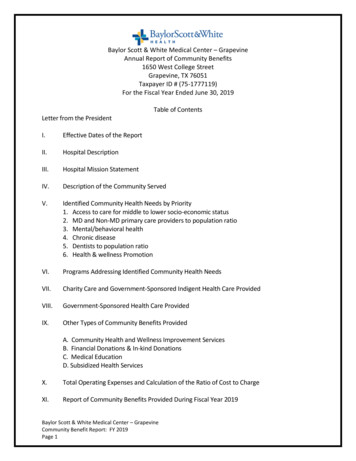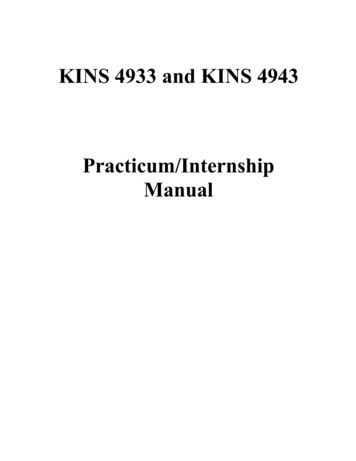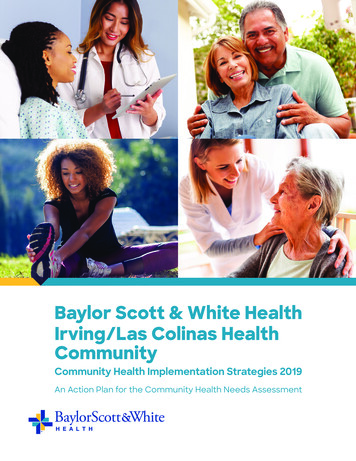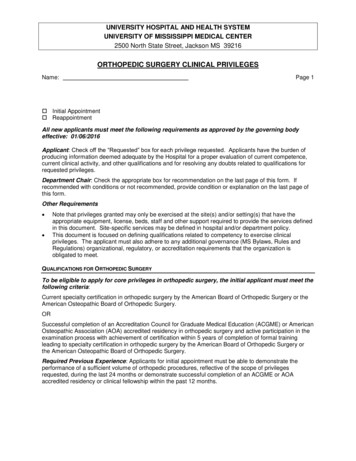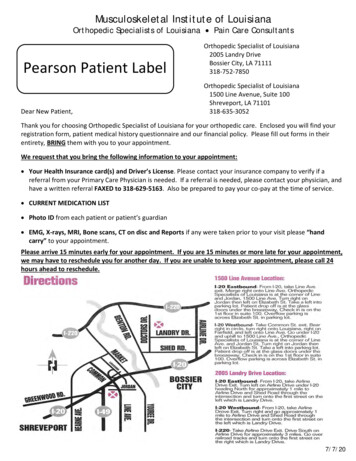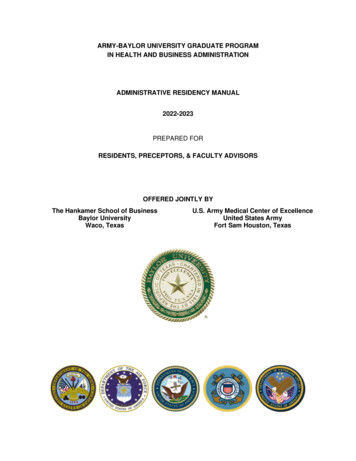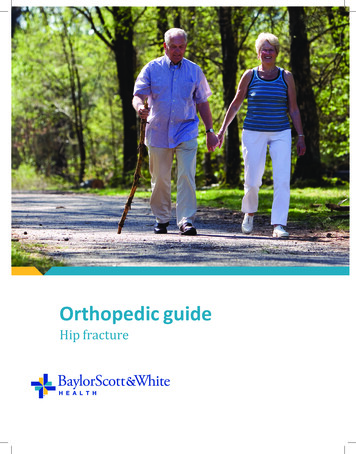
Transcription
Orthopedic guideHip fracture
What you will find in this guide4 Introduction11 After your hospital stay5 Understanding the hip jointand hip fractures12 At home6 Hip fracture treatment options7 What to expect afteryour hip is repaired14 Exercises15 Everyday living24 Equipment options8 How to prevent problemsThe material in this booklet is not intended for diagnosing or prescribing. Consult your physician beforeundertaking any form of medical treatment or adopting any exercise program or dietary guidelines.2 Hip fracture Baylor Scott & White HealthBaylor Scott & White Health Hip fracture 3
IntroductionUnderstanding the hip joint and hip fracturesWe know you are here under unexpected circumstances, and we want you andyour loved ones to know that we will provide you with quality care. At BaylorScott & White Health, we have a team approach to care. You and your family areimportant members of our team. A hip fracture is a serious injury, and togetherwe can lower the chance of complications.Intertrochanteric fractureYour healthcare team may include:Orthopedic surgeon – Performs surgery andplans your care, checks on you while you arein the hospital, evaluates you at your followup appointment.Hospital doctor (hospitalist or trauma surgeon)– Prepares you for surgery, cares for yourmedical needs during your hospital stay, andadjusts your medications as needed.Advanced practice provider (physicianassistant, advanced practice registerednurse) – Assists physicians with getting yourmedical information, may help during thesurgery, and follows up with you duringyour stay and after you go home.Anesthesia team – Gives you anesthesiaduring surgery, monitors your condition,and may help with pain managementafter surgery.Care coordinator/social worker – Coordinatesplans between you, your family, your doctors,nurses, and therapists when you are ready toleave the hospital. Makes plans for continuedcare after your hospital stay if needed andworks with your insurance provider.4 Hip fracture Baylor Scott & White HealthPhysical therapist (PT)/occupational therapist(OT) – Teaches you exercises to improve yourstrength, helps you get out of bed and startwalking, and teaches you how to adjust todaily life as you recover.Registered nurse (RN) – Provides your dailycare including giving you medicine, checkingyour vital signs, and talking to your doctorsand other team members about your needs.Patient care technician (PCT) – Assists withyour personal care including going tothe bathroom, bathing, meal set-up, andchecking vital signs.You may also be seen by lab, nutrition,pharmacy, radiology, and respiratory teammembers as well as chaplain services.Many team members will ask you questionsand give you information. We would like youto be involved in your care, so please askquestions and speak freely knowing that allinformation is kept confidential.Femoral neck fractureThe hip joint allows the upper leg to bend and rotate atthe pelvis. The acetabulum (hip socket) forms a deepcup that surrounds the femoral head (the ball at the topof the thigh bone). The femoral head is attached to therest of the femur (thigh bone) by a short section of bonecalled the femoral neck. The bump on the outside of thefemur just below the femoral neck is called the greatertrochanter. A hip fracture is a break anywhere in theupper part of the femur from the femoral head to justbelow the greater trochanter. To the right are examplesof where a hip fracture can occur.Subtrochanteric fractureHow hip fractures happenMost of the time hip fractures are caused by a fall ordirect blow to the hip. Osteoporosis is a disease thatcauses bones to become weak and more likely tobreak. For someone with osteoporosis, a break canhappen during regular activity like standing up from achair or walking. Some causes of osteoporosis are: Aging Lifestyle Family history Medication Nutrition IllnessBaylor Scott & White Health Hip fracture 5
Hip fracture treatment optionsThe treatment for your hip fracture starts bymaking sure you are medically stable. After this,decisions about how to treat the fracture can bemade. Most hip fractures are treated with surgeryto repair the broken bones. Sometimes surgeryis not recommended because of other healthconcerns. In this situation, your healthcare teamwill discuss other treatment options with you.Most hip fractures are treated inone of the following ways:Metal pins2 or 3 metal pins are used to hold thebroken bones together while they healMetal plates and screwsA plate on the outside of the bone and alarge screw are used to hold the brokenpieces of bone in place while they healIntramedullary nail (IM nail)A rod on the inside of the bone and alarge screw are used to hold the piecesin placeArtificial replacementWith a hemiarthroplasty (partialreplacement), the ball of the femur isreplaced with an artificial ball. A stemgoes down into the thigh bone to holdthe ball in position. The hip socket is leftin place.With a total hip arthroplasty (total hipreplacement), both the ball and the socket arereplaced with an artificial hip. The artificial hipjoint is made of metal and plastic parts.6 Hip fracture Baylor Scott & White HealthWhat to expect after your hip is repairedHaving surgeryActivity and therapyThe goal of surgery is to stabilize the hipjoint so you can get up and moving as soonas possible.Getting out of bed and moving soonafter surgery can lower the chance ofcomplications. You will be able to get outof bed and move around with help. We willhelp you get out of your bed to a chair assoon as possible. A physical therapist or anoccupational therapist will help you beginwalking with a walker, using the bathroom,and practicing getting dressed. You will startdoing exercises to strengthen muscles andto prevent blood clots.Before surgeryYou will not be able to eat for many hoursbefore surgery, but you may be able todrink clear liquids, like water, until about2 hours before surgery.Both the surgeon and the anesthesiologistwill visit with you before surgery. This isa good time to ask questions. After all ofyour questions are answered, you will signconsent forms. You will then be taken to theoperating room.After surgeryAfter surgery you will go to the recoveryroom. The recovery room is also called thePost Anesthesia Care Unit (PACU). Here,a nurse will monitor you closely. Otherpatients will be around you, and you mayhear sounds from monitors and othermachines. You may be sleepy and confusedat first. Your incision will probably feeluncomfortable and your throat may feelsore. Your nurse may give you medicine tomake you more comfortable.You will go to your regular room when youare ready to leave the PACU. Once you get toyour room, your nurse will come see you.The nursing team will check your vital signsand look at your bandage often during theday and night. They will make sure you arecomfortable and have what you need.Most patients are able to start putting all oftheir weight on the operated leg right aftersurgery. Depending on the break and how it isrepaired, you may be able to put only some ofyour weight down on the operated leg whileit heals. Your therapist will teach you howmuch weight you can put on your leg.you how to manage your pain. As yourbody heals and you are moving aroundmore, you will feel more comfortable.Pain managementNutritionIt is normal to have some pain after surgery.The incision area may burn and you may feelstiff at first. Your healthcare team will workwith you to make a pain management plan.A pain management plan uses a combinationof medications and other ways to manageyour pain. Medication may not completelystop the pain, but it will lessen the pain.There are other ways to manage pain such aschanging positions, moving around, andusing ice packs. Tell your healthcare teamwhen you are in pain. We will ask you to rateand describe your pain. We will decide withAs soon as you are awake, you can startdrinking fluids. When you are ready,you will be able to begin eating. Drinkplenty of water and eat healthy foods tohelp your body heal. Protein helps withhealing. Good sources of protein includemeats, dairy products, eggs, beans, and soyprotein. Include protein with all of yourmeals and snacks. Talk to your healthcareteam about taking a multivitamin to helpwith healing. A registered dietician canmeet with you while you are in the hospitalif you have concerns about your nutrition.Baylor Scott & White Health Hip fracture 7
How to prevent problemsPneumoniaAfter surgery, if you are in pain or not movingaround, you may take smaller breaths thannormal. This can cause fluid and mucusto collect in your lungs and could causepneumonia. To lower this chance and to keepyour lungs working their best, we will coachyou to cough, take deep breaths, and use anincentive spirometer. An incentive spirometeris a small, plastic device that shows you howdeep you are breathing. Use it 10 times everyhour you are awake to make sure you arebreathing deeply enough. Getting out of bedand sitting up in a chair as soon as possible willalso help you breathe more deeply.ConstipationSome people have constipation aftersurgery. Drink more fluids, like water, andeat more fiber to help with constipation.Good sources of fiber include whole grains,fruits and vegetables. Take stool softeners astold by your healthcare team.Pressure soresYou may want to stay still in bed if movingaround causes pain. However, when youstay in one position for very long withoutmoving, pressure on the skin can causepressure sores. The best way to preventpressure sores is to get out of bed with helpas soon as possible. Changing positionswhen you are in bed will also help.Urinary tract infection (UTI)A UTI is an infection in your bladder or yourkidneys. This may make it painful to urinateand may cause you to feel sick. To lower yourchance of getting a UTI, we will try to avoidputting a catheter in your bladder. If you do havea catheter, we will take it out as soon as possible.Drinking plenty of fluids and asking for helpto go to the bathroom as soon as you have theurge will also help lower your chance of a UTI.8 Hip fracture Baylor Scott & White HealthHow to prevent problemsBlood clotsAfter any surgery, a blood clot, also called adeep vein thrombosis (DVT), may happen. Ifa blood clot happens, it usually happens inthe thigh or calf. Ways to lower your chanceof a blood clot are: Getting up with help as soon as possible. Wearing foot pumps or calf pumps tohelp keep blood moving when you are inbed or reclined. Taking blood thinner medicine ifprescribed.Mental confusionThe stress of a hip fracture, unfamiliarsurroundings, pain medicine, and othermedical conditions can cause confusionand changes in behavior. This is sometimescalled delirium. Delirium usually goesaway within a few days or weeks. The besttreatment for delirium is for you to getmoving and out of the hospital. Familiarsurroundings, familiar faces, and regular dayand night activity schedules are very helpful.FallsThere is a greater chance of falling after ahip fracture. To lower the chance of a fallin the hospital, your healthcare team willwork with you to develop a fall preventionplan. We will talk about what makes youmore likely to fall and things we can doto lower your chance of falling. Followingthe fall prevention plan will keep yourrecovery on track. Talk to your therapistsand doctors if you have a fear of falling.It is normal to have a fear of falling, butthis fear can actually cause another fall.You need to talk about your fear so we canhelp. Falling is not a normal part of aging.InfectionTo lower the chance of an infection whileyou are in the hospital, everyone who comesin your room should clean their hands withsoap and water or hand sanitizer. Clean yourown hands often, also. Before changing thedressing (bandage) on your incision, youand anyone helping should wash handswell. Good hand washing should continuewhen you go home since hand contact is thenumber 1 way germs are spread.TherapyActivityWalking and exercising are keys to healingafter surgery. The sooner you get up and movearound with help, the faster you will feel better.It is very important to do your exercises inthe hospital and keep doing them after youleave the hospital. Do ankle pumps and quadsets often (see page 15). Your therapists willhelp you with exercising, walking, learning todo things on your own, and deciding whichequipment you may need.Physical therapy goalsYour physical therapists will work with youso you can:Occupational therapy goals Get in and out of bed on your own. Get dressed using tools with a little helpfrom another person. Stand up from and sit down on a bed orchair using a walker on your own.Your occupational therapists will work withyou so you can: Walk safely with a walker on your own. Safely sit down on and stand up from thetoilet using a walker on your own. Walk up and down a curb or steps using awalker with some help from another person. Get into and out of the tub or shower witha little help from another person. Do your home exercises with only a littlehelp from another person.Baylor Scott & White Health Hip fracture 9
After your hospital stayHow to prevent problemsChecklist to stay on track in thehospitalUse this checklist to guide your care inthe hospital. Do you have an incentive spirometer?Are you using it? Ask your nurse if youdo not have one or do not know how touse it.You may need more therapy to help you get stronger and able to move well afteryou leave the hospital. Because every patient is different, your care and therapywill be arranged to meet your individual needs. While you are in the hospital,your healthcare team can answer questions and concerns you have about plansfor leaving the hospital. Use this checklist to keep track of things you need toknow or do before going home. Make your follow-up appointments withyour healthcare team. Learn how to do your dressing changes.Where: Are you doing ankle pumps and quadsets often? Know what foods are good for you to eat.Date: Ask your therapists questions you haveabout getting around your home. Are you doing all of your exercises astold by your therapist?Time: Do you have foot pumps or calf pumpson when you are in bed or reclined? Practice exercises 3 times each day.Do slow, steady repetitions. Breathe asyou exercise.Where: Do you know what equipment you willneed when you leave the hospital? Put ice packs on your operated hip for upto 20 minutes after exercises.Date: Do you know your plans for care whenyou leave the hospital? Understand how important activity, rest,and exercise are for you to get better.Time: Know when you can drive. Are you working with your healthcareteam to manage your pain? Learn about new medications. Know when you can go back to work. Set up your first therapy appointment.Where:Notes:Date:Time:10 Hip fracture Baylor Scott & White HealthBaylor Scott & White Health Hip fracture 11
At HomeAt homeManaging painPreventing fallsAround the houseKeep doing the things that helped youmanage your pain in the hospital. Balancerest and activity. Make your home a placeto help you get better. Keep it free of clutter,open blinds and shades for natural light,keep noise at a comfortable level, and listento music you like. Take medication as toldby your healthcare team. Before you leave thehospital, talk to your healthcare team aboutwhat to do if your pain is not getting betteror is getting worse when you are home.Follow these tips to prevent falls at home. Remove items that may cause you to tripAbout you Be careful around pets especially small animals Wear glasses if needed Move furniture and electrical cords out ofwalking pathsPreventing pneumoniaContinue to take deep breaths and coughregularly. Take your incentive spirometerhome and use it 10 times every hour you areawake to help you take deep breaths. Getup and move around every hour during theday. Activity makes you breathe more deeplywithout realizing it. Doing these things willkeep your lungs working their best andlower your chance of getting pneumonia.Preventing blood clotsGet up and move around every hour duringthe day to lower the chance of blood clotsforming. Do ankle pumps when you aresitting. If your healthcare team told you totake blood thinners, take them as told.Changing the dressing (bandage) onyour incisionFollow the instructions given to you by thehealthcare team for changing the dressingand caring for your incision. Wash your handsbefore changing the dressing. Look at the12 Hip fracture Baylor Scott & White Health Talk to your healthcare team about all yourmedicines and side effects that make youmore likely to fallincision each time you change the dressing.Call your healthcare team if you notice moreredness, more drainage (fluid that comes outthe incision), or the drainage looks differentthan before. Put a clean dressing on and coverall parts of the incision.Preventing infectionWash your hands with soap and wateroften. Ask family members, friends, andcaregivers to wash their hands often.Before changing the dressing on yourincision, you and anyone helping shouldwash hands well. Ask visitors who are notfeeling well to visit after they are well. Take your time doing things—do not rush Keep your home well lit—use night lightsespecially on stairs, and turn lights on whengetting up during the night Wear well-fitting, low-heeled shoes withnonskid soles Sit in chairs that are easy to stand up from—low surfaces are hard to stand up from Do not wear socks without shoes onsmooth floors Keep items in easy to reach places—use along-handled reacher if something is outof reach Limit drinks with alcohol Use a walker, crutches, or cane if told byyour healthcare team—clean and replacerubber tips when neededWho and when to call for problemsFlooring Sudden chest pain Use nonskid floor wax Shortness of breath that is getting worse Avoid rugs on floors. If you use rugs, makesure they have a nonslip backing and edgesare secured downCall your surgeon for: Repair loose carpetPreventing constipation and urinarytract infections Clean up spills immediatelyDrink at least 8 glasses of fluids every day.Water is the best fluid to help preventconstipation and urinary tract infections.Go to the bathroom as soon as you feelthe urge. Some medication may causeconstipation. Ask your healthcare team aboutover the counter medication you can taketo help with constipation. Getting up andmoving around during the day will also help. Use non-slip mats near sinks and showersto absorb waterBathrooms Have handrails installed Have a gripped surface on the bottom oftubs and showers Sit on a tub bench or shower chair forsafe bathingCall 911 for: Passing out Pain that is not getting better or gets worse Fever over 101.5 F Sudden calf pain and swelling Incision opening up or bleeding Incision becoming redder, hard, or has pus Urine (pee) that is cloudy or smells very bad Constipation that does not get better aftertaking a stool softener Nausea, vomiting, or diarrhea Chest pain with breathing or coughing A change in mental condition Confusion that is new Not getting better as expectedBaylor Scott & White Health Hip fracture 13
ExerciseEveryday livingExercises help you get well faster and bring back your strength. Do yourexercises at least 2 to 3 times each day. Below are exercises you will be doingafter surgery. Start by repeating each exercise 10 times. Gradually increase torepeating each exercise 20 times. Take slow, steady breaths as you exercise. DoNOT hold your breath.You may not need to change the way you do some of the following activitiesdepending on your surgery. Talk to your therapist before leaving the hospitalabout what you need to do.Getting into bedGetting out of bed1. Stand at the side of the bed halfwaybetween the head and foot of the bed.1. Sit up in the bed by pushing up withboth arms.2. Back up to the bed until you feel the edgeof the bed touch the backs of your legs.2. Move your legs toward the side of thebed and turn your body to face thesame direction.3. Reach back, put your hands on the bed,and slowly sit down on the bed.Ankle pumpsGluteal sets (buttocks squeezes)1. Lie on your back or sit in a chair.1. Lie on your back.2. Gently point and flex your ankles.2. Squeeze the muscles in yourbuttocks together.3. Repeat.3. Hold 5 seconds.4. Relax.5. Repeat.4. Scoot your hips back toward the middleof the bed.5. Once you are stable on the bed, move thewalker out of the way, but keep it in reach.6. First lift one leg and turn so your leg is onthe bed. Then lift your other leg onto thebed. You can use a cane, rolled bed sheet,or belt to help lift your operated leg.7. Move your hips toward the middle of the bed.8. Lie back.Quad sets (thigh squeezes)Heel slides1. Tighten the muscles on top of boththighs, and push the backs of yourknees into the bed.1. Lie on your back with your legs straight.2. Hold 5 seconds.3. Straighten your leg slowly.3. Relax.4. Repeat.3. Scoot your hips to the edge of the bed.4. Lower your feet to the floor. You can use acane, a rolled bed sheet, or a belt to helpyou lower your operated leg.5. Use both hands to push yourself up off thebed. If your bed is low, put one hand on thewalker as you push yourself up off the bedwith your other hand.6. Stand at the side of the bed with bothhands on the walker before you startwalking to make sure you are stable.2. Bend your operated leg and slide yourfoot toward your body.4. Repeat.14 Hip fracture Baylor Scott & White HealthBaylor Scott & White Health Hip fracture 15
Everyday livingEveryday livingGetting in and out of a chairUsing the toiletUse a chair that has arm rests for 12 weeksafter surgery.When sitting down on the toiletGetting into a chair1. Take small steps and turn until your backis toward the toilet.1. Take small steps and turn until your backis toward the chair.2. Back up to the toilet until you feel it touchthe back of your legs.2. Slowly back up to the chair until you feelthe chair against the backs of your legs.3. Slide your operated leg out in front as yousit down.3. Slide your operated leg forward.4. If using a toilet with arm rests, reach backfor both arm rests and lower yourself ontothe toilet.4. Hold the arm of the chair with one handand hold the walker with the other hand.Slowly lower your body into the chair.5. Move the walker out of the way, but keep itwithin reach.Getting out of a chair1. Scoot your hips toward the front edge ofthe chair.2. Hold the arm of the chair with one handand hold the walker with the other hand.DO NOT put both hands on the walkerwhile getting out of the chair.3. Lift yourself off the chair.4. Balance yourself before trying to walk.5. If using a raised toilet seat without armrests, keep one hand on the walker as youreach back for the toilet seat with yourother hand.When getting up from the toilet1. Slide your operated leg out in front of youbefore you stand up.2. If you are using a toilet with arm rests,put your hands on the arm rests andpush yourself up, then move your handsto the walker.3. If you are using a toilet without arm rests,put one hand on the walker and push offthe toilet seat with your other hand.4. Balance yourself before you start to walk.16 Hip fracture Baylor Scott & White HealthBaylor Scott & White Health Hip fracture 17
Everyday livingEveryday livingGetting in and out of a walk-in showerGetting in and out of the bathtubAlways use nonslip mats both inside andoutside of the shower for safety.Always use a rubber mat in the tub. If you donot have one, put nonskid strips in the bottomof the bathtub.Getting into the shower using a shower chair1. Back up to the shower lip. Feel the lipbehind both heels.2. Place the walker or crutches against the lip.3. Push through your arms and step slowlyover the lip with your good leg.4. Step over the lip with your operated leg.5. Turn, without twisting so you face thefaucet with a shower chair behind you.6. Sit on the shower chair. Leave the walkeror crutches outside of the shower.Getting out of the shower using a shower chair1. Use both hands to push yourself up from theshower chair to get to a standing position.2. Turn toward the shower door so you arefacing the walker. Use either a grab bar orplace your hand flat against the showerwall for balance.3. Place both hands on the walker.4. Step up over the lip with your operated leg.5. Step up and over the lip with your goodleg. Balance yourself using the walkerbefore trying to walk.Getting into the bathtub using a tub bench1. Place the tub bench in the bathtub withthe seat facing the faucets.2. Stand in front of the tub bench and back up tothe bathtub until you feel the edge of the tubbench behind your legs.3. Reach back for the tub bench with one hand.Keep your other hand on the walker.4. Slowly lower yourself to the to sit on thetub bench.5. Move the walker out of the way, but keep itwithin reach.6. Lift your legs one at a time over the side ofthe bathtub as shown in the picture.7. Scoot your hips to the middle of the tub bench.Getting out of the bathtub using a tub bench1. Scoot your hips to the edge of the tub bench.2. Lift each leg over the side of the tub – you mayneed to scoot your hips closer to the edge ofthe tub bench as you lift your legs over.3. Turn your body so you are facing the walker.4. Hold onto the walker with one hand. Use your otherhand to push up on the back of the tub bench.5. Stand up from the tub bench.6. Balance yourself before trying to walk.18 Hip fracture Baylor Scott & White HealthBaylor Scott & White Health Hip fracture 19
Everyday livingEveryday livingPutting on pantsTaking off pants and underwearPutting on socksPutting on shoes se a “reacher” or “dressing stick” to pull onUpants and underwear.1. Back up to the chair or bed where you willbe undressing.Use a sock aid to put on socks.Use a long-handled shoehorn to put on shoes.1. Sit on a chair or bed.1. Sit down. Have your walker within reach.2. Undo your pants and let them drop tothe floor.1. Sit on a chair or bed. Slide the sock all theway onto the sock aid.2. Grab the underwear or pants with thereacher.3. Push your underwear down to your knees.3. Move the reacher so your clothing is byyour feet.4. Keep your operated leg straight and loweryourself to sit on the chair or bed.4. First put your foot from your operated leginto the clothing, then put your other foot in.5. Use the reacher to help get your good legand foot out of the pants and underwear.Next take your operated leg out of theclothing.5. Use the reacher to pull your pants up overyour knees where you can reach them.6. Stand up with your walker, then pull yourpants up the rest of the way.20 Hip fracture Baylor Scott & White Health6. Use the reacher to move the pants andunderwear off the floor so you do not tripover the clothes.2. Hold the cords and drop the sock aid infront of your foot. It is easiest to do this ifyour knee is bent.3. Slip your foot into the sock aid.4. Straighten your knee, point your toe,and pull the sock on.5. Keep pulling until the sock is on your footand the sock aid hangs free.2. Wear sturdy shoes or shoes with Velcro closures or elastic shoelaces. DO NOT wearhigh heeled shoes or shoes without backs.3. Use the long-handled shoehorn to slideyour shoes in front of your feet.4. Put the shoehorn inside the shoe againstthe back of the heel. Line up the curve ofthe shoehorn with the inside curve of theshoe heel.5. Lean back if you need to, lift your leg,and put your toes in your shoe.6. Step down into your shoe and slide yourheel down the shoehorn.Baylor Scott & White Health Hip fracture 21
Everyday livingEveryday livingGetting in and out of the carGoing up and down stairs1. Have someone move the front passenger seat all the way back to allow more legroom.Do not go up and down stairs until yourdoctor or therapist says it is okay.2. Lean the seat back if needed.3. If you have cloth seat covers, put a plastic trash bag on the seat cushion to help you slideonce you are seated.An easy way to remember which leg goes firstis: up with the good, down with the bad.Going up stairs4. Using your walker, back up to the front passenger seat.5. Steady yourself with one hand on the walker.1. Using the handrail for support, start byplacing your good leg up on the first step.6. With your other hand, reach back for the seat and lower yourself down, keeping youroperated leg straight out in front of you as shown in Figure 1, below. Be careful not to hityour head when getting in.2. Bring the operated leg (bad leg) up to thesame step.7. Turn frontward and lift your operated leg into the car as shown in Figure 2 below.4. D O NOT climb the stairs in the normalfoot over foot way until your surgeon ortherapist tells you it is safe.8. Put the seat back up in a sitting position if you leaned it back.9. To get out of the car, reverse these steps.Figure 13. Repeat until you reach the top.Figure 2Going down stairs1. Using the handrail for support, place youroperated leg (bad leg) down on the first step.2. Bring your good leg down to the same step.3. D O NOT go down the stairs in the foot overfoot way until your surgeon or therapisttells you that it is safe.22 Hip fracture Baylor Scott & White HealthBaylor Scott & White Health Hip fracture 23
Equipment optionsAdditional notesBelow are options of equipment that make everyday activities safer and easierafter surgery.Rolling walkerCrutchesHelps you balancewhen walking.If you do not need thesupport of a walker,crutches will help youwhen you walk.Bedside commode or3-in-1 commodeElevated toilet seatRaises the toilet seatand gives you arm restsfor support. Can be usedas a bedside commode,over a toilet, or as ashower chair in awalk-in shower.Raises the toilet seatan
2 Hip fracture Baylor Scott & White Health Baylor Scott & White Health Hip fracture 3 What you will find in this guide 4 Introduction 5 Understanding the hip joint and hip fractures 6 Hip fracture treatment options 7 What to expect after your hip is repaired 8 How to prevent problems 11 After your hospital stay 12 At home 14 Exercises 15 Everyday living .


